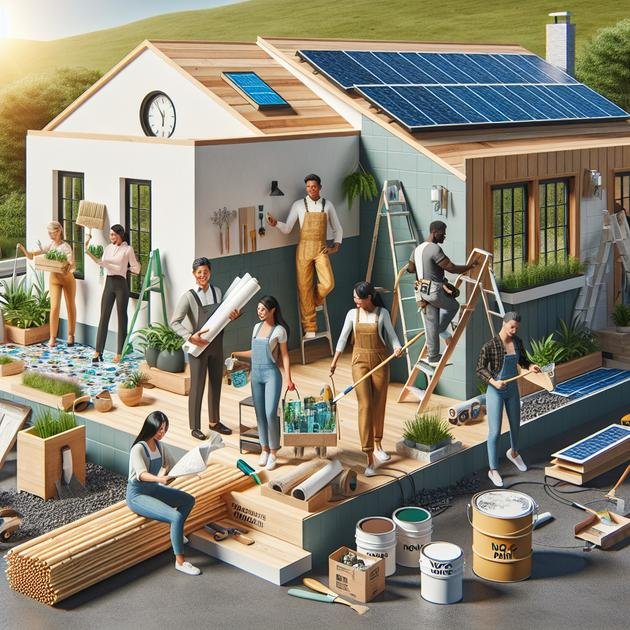Sustainable home renovation involves using eco-friendly materials, energy and water-efficient upgrades, waste reduction, and trusted contractors to create an environmentally responsible, cost-effective, and comfortable living space.
Sustainable home renovation is more than a trend—it’s a way to make your living space greener and healthier. Curious about how small choices in your renovation can create big impacts? Let’s explore practical ideas that bring eco-friendly benefits home.
Understanding sustainable home renovation principles
Sustainable home renovation focuses on improving your living space while reducing environmental impact. It involves using materials and methods that conserve resources, minimize waste, and lower energy consumption.
Key principles to follow
Energy efficiency is crucial. Upgrading insulation, windows, and heating systems helps maintain temperature and cut energy bills. Choosing durable, low-impact materials extends the life of your renovation.
Resource conservation means selecting products that use less water and energy, like low-flow fixtures and energy-efficient appliances. It also involves reusing and recycling materials from your old home to limit landfill waste.
Indoor air quality matters too. Using non-toxic paints, sealants, and finishes ensures a healthier environment for you and your family.
Building with sustainability in mind also means thinking long term—planning renovations that adapt to changing needs without requiring frequent replacements.
Choosing eco-friendly materials and products
Choosing eco-friendly materials is essential for a sustainable home renovation. These materials have low environmental impacts, often made from renewable resources or recycled content. For example, bamboo flooring grows quickly and is a strong alternative to traditional hardwood.
Types of eco-friendly materials
Natural fibers like wool or cotton, reclaimed wood, recycled metal, and low-VOC paints reduce toxins inside your home and minimize waste. Selecting products with environmental certifications, such as FSC or Energy Star, ensures they meet sustainability standards.
Durability and local sourcing are key factors. Durable materials lower the need for frequent replacements, and buying locally reduces transportation emissions. Also, avoid materials with harmful chemicals or those that contribute to deforestation.
When selecting products like insulation, cabinetry, or countertops, look for those made with recycled or sustainable content. This not only lessens environmental harm but often improves indoor air quality and energy efficiency.
Energy-efficient upgrades that make a difference

Energy-efficient upgrades are vital in sustainable home renovation. They reduce utility bills and lower your carbon footprint. Common upgrades include installing LED lighting, energy-efficient windows, and modern insulation that keep your home comfortable year-round.
Heating and cooling improvements
Upgrading to a high-efficiency HVAC system or using programmable thermostats can significantly cut energy use. Heat pumps are also a smart choice as they provide both heating and cooling efficiently.
Solar panels are another popular upgrade, enabling homes to generate clean energy on-site. Even small additions like energy-efficient appliances and smart home systems contribute to lowering overall energy consumption.
Sealing gaps and improving ventilation with energy recovery ventilators help maintain indoor air quality while saving energy. Together, these upgrades create a more comfortable, sustainable home that saves money over time.
Water conservation techniques for your home
Water conservation is an important aspect of sustainable home renovation. Installing low-flow faucets, showerheads, and toilets can significantly reduce water usage without sacrificing comfort. These fixtures use less water while maintaining strong pressure.
Rainwater harvesting
Collecting rainwater using barrels or storage tanks is a practical way to reduce reliance on municipal water. This water can be used for gardening, flushing toilets, or cleaning outdoor areas.
Greywater systems recycle water from sinks, showers, and washing machines for irrigation or toilet flushing. This reduces wastewater and conserves fresh water.
Simple steps like fixing leaks, using water-efficient appliances, and landscaping with drought-resistant plants also help save water. Together, these techniques promote a responsible use of water in your home.
Incorporating renewable energy solutions
Incorporating renewable energy solutions is a key step in sustainable home renovation. Solar panels are the most common option, converting sunlight into electricity to power your home and reduce utility bills.
Other renewable options
Wind turbines and geothermal systems can also be effective depending on your location and budget. Geothermal heat pumps use the earth’s constant temperature to heat and cool your home efficiently.
Battery storage systems allow you to store excess energy generated by solar panels for use when the sun isn’t shining. This increases your home’s energy independence and reliability.
Incorporating renewable energy not only helps the environment but can increase your home’s value and provide long-term savings on energy costs. Careful planning and consultation with experts ensure the right system for your needs.
Waste reduction and recycling during renovation

Waste reduction and recycling are essential components of sustainable home renovation. Minimizing waste starts with careful planning, ensuring materials are accurately measured and ordered to prevent excess. Salvaging and reusing existing materials like wood, bricks, or fixtures can reduce the need for new supplies.
Sorting and recycling construction waste
Separate materials such as metal, concrete, glass, and wood on-site to facilitate recycling. Many communities offer recycling centers for construction debris, helping divert waste from landfills.
Donating usable materials like doors, cabinets, or tiles to local charities or reuse stores extends their life and supports the community.
Using biodegradable or recyclable packaging and choosing suppliers with sustainable practices also supports waste reduction. Effective waste management during renovation not only protects the environment but often saves money and resources as well.
Balancing budget with sustainability goals
Balancing your budget with sustainability goals requires smart planning and prioritization. Start by identifying high-impact upgrades that offer long-term savings, like insulation improvements or energy-efficient windows.
Setting priorities
Focus on changes that reduce utility bills and maintenance costs. It’s often better to invest more initially in durable products that save money over time.
DIY projects can help reduce labor costs while allowing you to choose eco-friendly materials. However, complex tasks like installing solar panels should be left to professionals to ensure safety and efficiency.
Compare prices and look for government incentives or rebates for sustainable upgrades. Planning and research help maximize your budget without compromising your green goals.
Tips for finding trustworthy contractors and experts
Finding trustworthy contractors and experts is crucial for a successful sustainable home renovation. Start by checking credentials such as licenses, certifications, and insurance to ensure professionalism and legal compliance.
Gather multiple quotes
Request detailed estimates from several contractors to compare costs and services. This helps identify who offers the best value and understands sustainable practices.
Ask for references and portfolios of previous projects, especially those focused on eco-friendly renovations. Speaking with past clients can reveal insights into reliability and quality.
Clear communication is vital. Choose contractors who are transparent about materials, timelines, and costs. Ensure they have experience with sustainable materials and energy-efficient systems.
Lastly, trust your instincts. A good working relationship with your contractor promotes a smoother renovation process and better results.
Making sustainable home renovation work for you
Sustainable home renovation offers many ways to improve your living space while protecting the environment and saving money. By choosing eco-friendly materials, upgrading energy and water efficiency, and reducing waste, you make a positive impact.
Balancing your budget and working with trustworthy experts ensures your project runs smoothly and meets your green goals. Small changes can add up to big benefits over time.
With careful planning and commitment, your home can become more comfortable, healthy, and sustainable for years to come. Start making thoughtful choices today to enjoy these rewards tomorrow.





